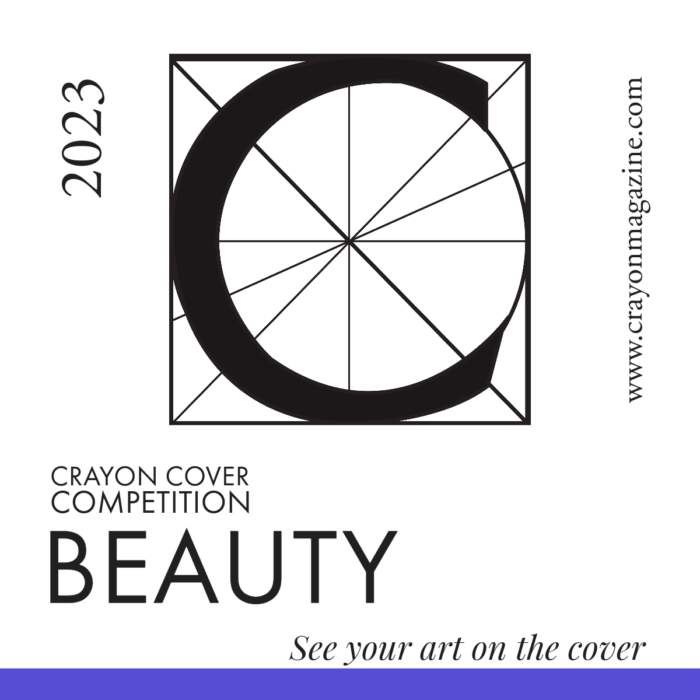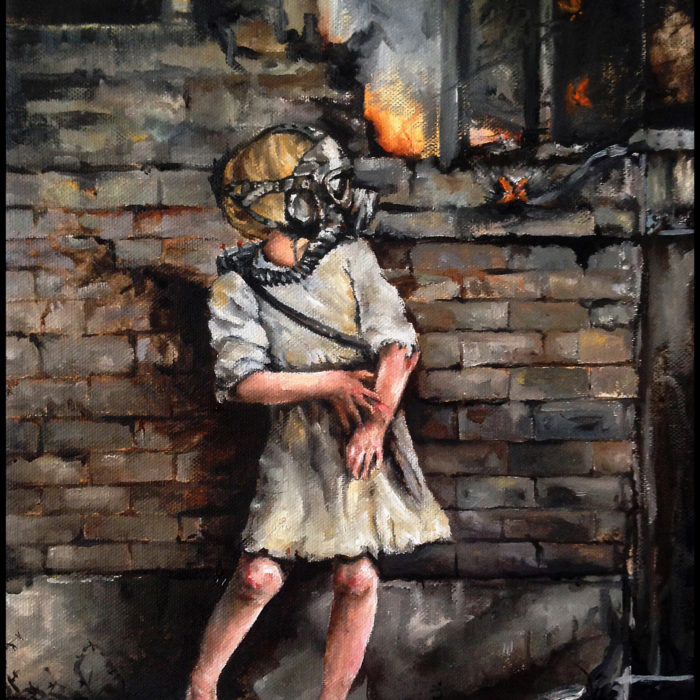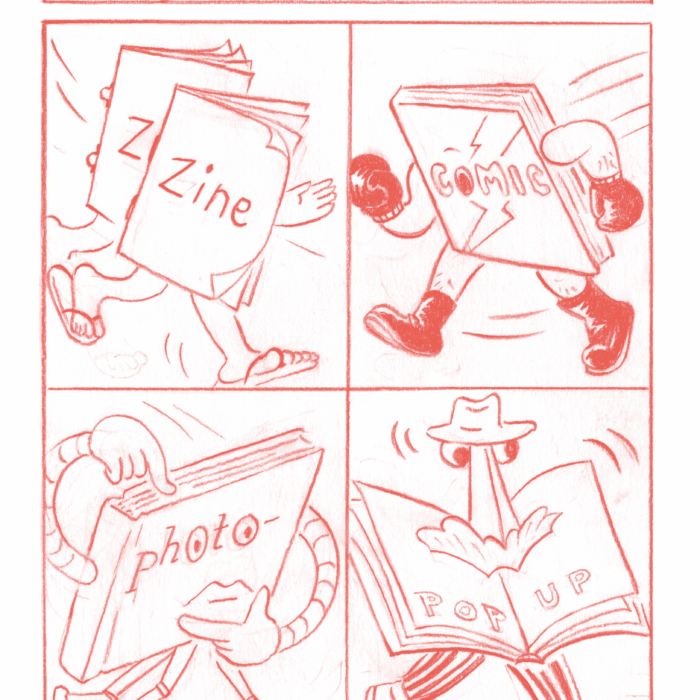You have no items in your cart. Want to get some nice things?
Go shopping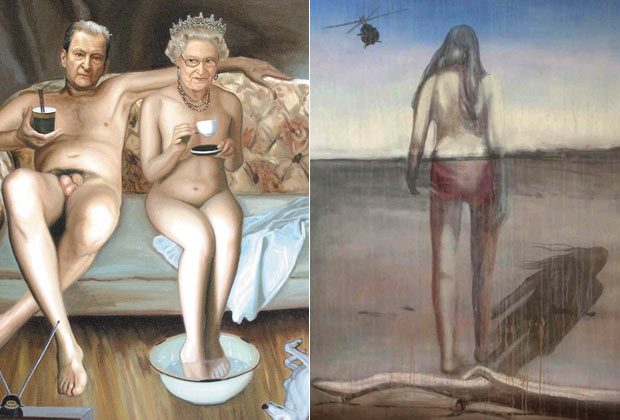
Everyone tells me that The Queen has an excellent sense of humor. Sadly, I did not get a chance to test this, since my painting – An Audience with the Queen, which features the monarch and Lucian Freud seated naked on a couch sipping tea and eating Pot Noodles– that was meant to be shown in Dublin for the Queen’s first state visit had to be quickly taken down following some protests.
This month the painting is being given a proper showing on rue de l’Odéon in Paris at Galerie Olympe de Gouges. The response so far has been tremendous, but then the French have never been shy about talking about sex or anything else. The surprise for British readers then is that they have so much sense of humor about it. Half the show is devoted to exploring the stories of those other two great British icons: Francis Bacon and Lucian Freud, whose complicated personal lives and relationships with their models provides grist for the large panoramic paintings.
“Her images will not serve for distraction,” says Professor Patrick Healy of Delft University of Technology. “They need attention and thought. They are there to confront and be confronted. Funk presents art as a scene of a crime, a laboratory and theatre where the vivisection of the gaze is the active wrenching from reality of the artist’s precise concerns; the first extraction and reduction.”
Healy continues: “The sharp satire of Funk’s work has now gone to a topic usually highly insulated in terms of imagery. Royalty in Europe depends more and more on image to remain royal in the absence of more traditional means of power. The other taboo which is broken here is that around old age and the rituals of its decay. The stagy setting and the banal activities including the palpable fleshiness of the couple, is as strong as the withering pictures of Hogarth, and is indeed stronger than caricature as it does not depend on exaggeration or distortion, but a precisely imagined reality which traditional image making kept very purposely at bay. This suggests a strange pictorial iconoclasm, where pictures are used to attack imagery in favour of another communication.”
Sending up and being critical of power is a very British tradition. Soon I will have the honor of interviewing and painting the portrait of twice Booker Prize-winning novelist Hilary Mantel. In novels like Wolf Hall and Bring Up the Bodies, she has delivered in-depth psychological portraiture of those in King Henry VIII’s court, most notably Thomas Cromwell. And the title of her recent short story collection The Assassination of Margaret Thatcher tells you that this is not an author who stands on decorum. Indeed, a few years ago, she created a stir by making what to my mind is the fair, indeed feminist assertion that the way Kate Middleton, Duchess of Cambridge, was being covered in the press was like that of a “jointed doll on which certain rags are hung” and made comparisons with her and Marie Antoinette, “a woman eaten alive by her frocks.”
Satire may be a popular British pastime, but it is not my normal mode.
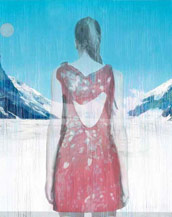
So the other half of the show is devoted to works in my Memory of Water series. My family works in theatre and film design; creating mise-en-scène, backgrounds, setting moods. I’ve always been fascinated by film, the moment at the end or the beginning of a scene when you see the traces of the scene before. Transitions. You see this in even the earliest silent movies where the preceding scene leaves an afterburn on the following one. This goes back to an interest in memory and the creative process itself. The moment you try to remember something, to pin it down, it begins to vanish. When I was young I experienced problems with my vision like large sunspots or floaters that blotted out my sight. It was frightening, but also there was an intensity of colour. And whatever I looked at would vanish behind these fields of light. I try to reproduce this effect in painting.
Debora Levi, director of artist relations at Artist Pension Trust Europe, says: “Mia’s paintings are replete with dichotomy. Her works are marked by transparency that reveals certain disturbing absences, which, as a viewer I may say evokes memories. Mia’s work is sometimes subtle and even seemingly faded. Her brushstrokes suggests rather than describes a figure or a scene such as landscape or a private moment.”
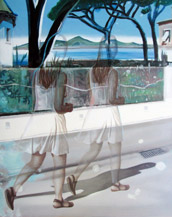
I want to tell surreal, enigmatic stories while still portraying a recognizable world. I am interested in beauty, but the paintings also deal with themes that affect us today––the environment, immigration and exile, surveillance society, memory and loss.
Victoria Otero, gallerist and associate curator at Artist Pension Trust, says: “Mia Funk explores in her work both the feminine and masculine parts of painting. She knows how to be realistic on the verge of making us uncomfortable by the strength of her ‘Inside the Artist’s Studio’ series, and how to represent the ephemeral oneiric part of life, where time and space are separated from one another.”
Some people have said my paintings are like “between two worlds”. I think that they literally mean my use of transparency and double figures creates a duality, but it may also be the observation that I have one foot in traditional painting, while being at the same time contemporary. There is a risk when pursuing avant-garde effects that we lose our roots, the knowledge which painters have accumulated over the centuries. I studied in Paris and in Florence, where I learned oil painting and older, pre-Renaissance techniques. A part of me is also indebted to watercolor and ink painting; a lightness of touch drawn from my Chinese roots. And yet today young painters are graduating from art schools–many of them don’t even have basic painting skills–but they know how to market themselves. We need to honour the past or it will be lost to us.
I was in Venice during the summer for the Biennale and was speaking to the art historian and gallerist, Jacopo Scarpa. His gallery APS, specialising in Old Masters, is located next to the Accademia. He has recently started a petition against the new management of the Uffizi and Brera Museums. The Uffizi is now run by Eike Schmidt, a former director Sotheby’s London. Scarpa agrees that changes need to be made to Italian museums in order for them to be modernized, but wants to caution against the risk of making ill-advised art sales in order to carry those changes out. Already he has thousands of signatures from museum directors, art historians, critics and the general public who share his views. In this way, the challenge that museums in Italy are facing today is also that of being caught “between two worlds” – but their worlds are commerce and culture, and how they manage it is crucial for the preservation of Italian art.
I got to speaking to Scarpa about his current projects, which include authenticating by using X-rays and light microscopy on paintings by Titian, Lorenzo Lotto and others. It is a fascinating, multi-layered process with its roots in archaelogy, of which Scarpa is also a professor. Additionally, he has been expert advisor for the American artist Fred Wilson when he represented the US at the Venice Biennale in 2003, but is dissatisfied with much contemporary art he sees. He says we need to return to learning from the Old Masters the way we used to. In Italy today if you go to a museum as an art student and try to paint a copy you will be arrested.
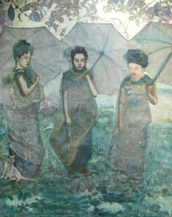
Scarpa and I share the same point of view when it comes to line and color. “It’s unusual to find both things in a contemporary artist,” he says of my paintings. “The End of Summer is probably my favourite. Autumn, Saudade or Les Mangeuses de Lotus Bleu are a door to her imagination and sensibility, while others, like the portraits for example, are a more stark representation of reality. It’s unusual to find both the things in a contemporary artist. Why did I like The End of Summer? Because–and that’s another unusual thing in contemporary art–Funk’s paintings show a knowledge of medium that is close to those I’m used to seeing in my beloved Old Masters: for a Venetian the colour is a tridimensional thing, made of physical strokes, masses of pigment that have to find peace on the canvas. The red stripe on the seashore clearly wins against the lines found elsewhere in the painting, and that’s really moving for me. In fact this war between colour and line is the subject of 500 years of discussions between the Florentine (lines) and Venetian (colour) school, as already Vasari pointed out.”
To see more paintings bridging the gap between color and line, visit Mia Funk’s exhibition at Galerie Olympe de Gouges (11 rue de l’Odéon, Paris) until 11th November.

About Mia Funk
Mia Funk, Mia has received many awards & nominations, including a Prix de Peinture (Salon d’Automne de Paris), Thames & Hudson Pictureworks Prize, Sky Arts Portrait Artist of the Year, KWS Hilary Mantel Short Story Prize, Doris Gooderson Prize, Aesthetica Magazine's Creative Works, Momaya Prize & Celeste Prize. Her paintings have been featured on radio and television, at group shows at the Grand Palais, and are held in several public collections, including the Dublin Writers Museum. She is currently working on portraits for the American Writers Museum, completing a novel and a collection of linked short stories.


